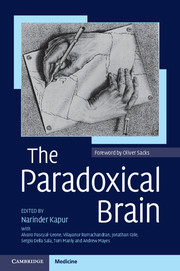Book contents
- Frontmatter
- Contents
- Acknowledgements
- Preface
- Foreword
- Author affiliations
- Abbreviations
- 1 The paradoxical nature of nature
- 2 Paradoxical effects of sensory loss
- 3 Paradoxical functional facilitation and recovery in neurological and psychiatric conditions
- 4 Paradoxes in neurorehabilitation
- 5 The paradoxical self
- 6 Paradoxical psychological functioning in early child development
- 7 Cognitive ageing: a positive perspective
- 8 Paradoxes of learning and memory
- 9 The paradox of human expertise: why experts get it wrong
- 10 Paradoxes in Parkinson's disease and other movement disorders
- 11 Paradoxical phenomena in epilepsy
- 12 Paradoxical creativity and adjustment in neurological conditions
- 13 Paradoxical functional facilitation with noninvasive brain stimulation
- 14 Unexpected benefits of allergies and cigarette smoking: two examples of paradox in neuroepidemiology
- 15 The paradox of autism: why does disability sometimes give rise to talent?
- 16 Paradoxes in creativity and psychiatric conditions
- 17 The paradox of psychosurgery to treat mental disorders
- 18 The paradox of electroconvulsive therapy
- 19 Paradoxes of comparative cognition
- 20 Paradoxical phenomena in brain plasticity
- 21 Immature neurons in the adult brain. Breaking all the rules
- 22 The paradoxical hippocampus: when forgetting helps learning
- 23 Paradoxical effects of drugs on cognitive function: the neuropsychopharmacology of the dopamine and other neurotransmitter systems
- 24 The paradoxical brain – so what?
- Index
- References
5 - The paradoxical self
Published online by Cambridge University Press: 05 December 2011
- Frontmatter
- Contents
- Acknowledgements
- Preface
- Foreword
- Author affiliations
- Abbreviations
- 1 The paradoxical nature of nature
- 2 Paradoxical effects of sensory loss
- 3 Paradoxical functional facilitation and recovery in neurological and psychiatric conditions
- 4 Paradoxes in neurorehabilitation
- 5 The paradoxical self
- 6 Paradoxical psychological functioning in early child development
- 7 Cognitive ageing: a positive perspective
- 8 Paradoxes of learning and memory
- 9 The paradox of human expertise: why experts get it wrong
- 10 Paradoxes in Parkinson's disease and other movement disorders
- 11 Paradoxical phenomena in epilepsy
- 12 Paradoxical creativity and adjustment in neurological conditions
- 13 Paradoxical functional facilitation with noninvasive brain stimulation
- 14 Unexpected benefits of allergies and cigarette smoking: two examples of paradox in neuroepidemiology
- 15 The paradox of autism: why does disability sometimes give rise to talent?
- 16 Paradoxes in creativity and psychiatric conditions
- 17 The paradox of psychosurgery to treat mental disorders
- 18 The paradox of electroconvulsive therapy
- 19 Paradoxes of comparative cognition
- 20 Paradoxical phenomena in brain plasticity
- 21 Immature neurons in the adult brain. Breaking all the rules
- 22 The paradoxical hippocampus: when forgetting helps learning
- 23 Paradoxical effects of drugs on cognitive function: the neuropsychopharmacology of the dopamine and other neurotransmitter systems
- 24 The paradoxical brain – so what?
- Index
- References
Summary
Summary
We consider a number of syndromes incorporating paradoxical phenomena that lie at the boundary between neurology and psychiatry. Amongst the phenomena we examine are Cotard's Syndrome (belief that one is dead/dying), Capgras Syndrome (belief that a personally familiar person has been replaced by an imposter), and Apotemnophilia (desire to have a limb amputated). We use these phenomena to speculate on the manner in which the brain constructs a sense of self. We propose that, despite the extraordinary variety of paradoxical symptoms encountered in neuropsychiatry, certain key assumptions can help explain most of these self-related phenomena. (1) Discrepancies and conflict between the information dominating different brain systems. (2) Disturbance of Me/Other distinctions caused by dysfunctional interactions between the mirror neuron system, frontal lobe structures and sensory input. (3) Misattribution of symptoms to spurious causes, so as to minimize internal discrepancies. (4) The existence of three functionally distinct visual systems, as opposed to the two conventionally accepted ones, with selective damage or uncoupling between them. (5) Recruiting one neural map for another unrelated function, or one neural structure serving as a template for transcribing on to another neural structure. We suggest that, paradoxically, the mechanisms that give rise to psychiatric delusions and illusions may themselves sometimes have adaptive value in evolutionary terms.
Introduction
An approach we have pursued in our laboratory involves exploring precisely those phenomena that have long been regarded as paradoxical or anomalous, that do not fit the overall framework of science as currently practised, or that appear to violate established conventional assumptions.
- Type
- Chapter
- Information
- The Paradoxical Brain , pp. 94 - 109Publisher: Cambridge University PressPrint publication year: 2011
References
- 2
- Cited by



